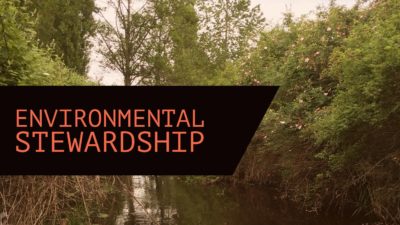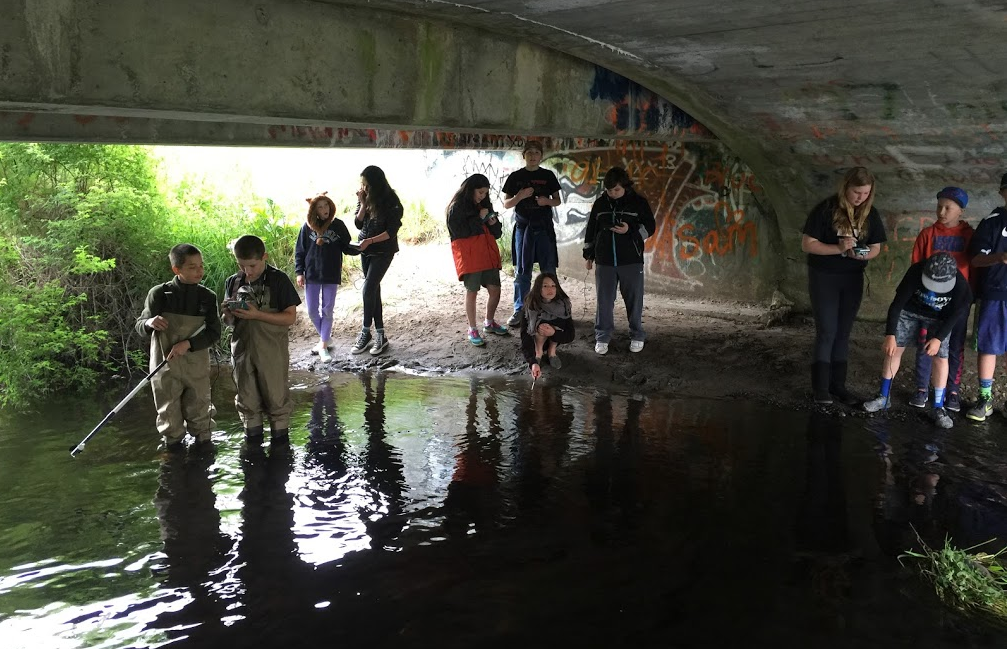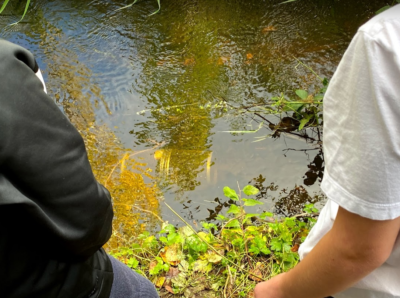 Chimacum Middle School 6th graders have been monitoring our neighborhood creek, Chimacum Creek, for the past 15 years! When asked to to develop an integrated STEM unit this year for our 6th graders I went to my fellow 6th grade teachers, the Humanities teacher, Ms. Langston, and the Math teacher, Mr. Meacham, and asked them if we could develop our integrated STEM unit around the Environmental Stewardship project that my 6th graders do every spring. They said yes and what follows is the document we created on Google Docs detailing the project including the CCSS and NGSS standards this project targets. Our superintendent paid us for our time spent developing this unit, which is not all that common and very much appreciated! Being treated like professionals is something we as educators have to advocate for. Here’s what we came up with:
Chimacum Middle School 6th graders have been monitoring our neighborhood creek, Chimacum Creek, for the past 15 years! When asked to to develop an integrated STEM unit this year for our 6th graders I went to my fellow 6th grade teachers, the Humanities teacher, Ms. Langston, and the Math teacher, Mr. Meacham, and asked them if we could develop our integrated STEM unit around the Environmental Stewardship project that my 6th graders do every spring. They said yes and what follows is the document we created on Google Docs detailing the project including the CCSS and NGSS standards this project targets. Our superintendent paid us for our time spent developing this unit, which is not all that common and very much appreciated! Being treated like professionals is something we as educators have to advocate for. Here’s what we came up with:
Introduction
The Chimacum Environmental Stewardship Project exists to raise the awareness of our students as to the needs of our natural environment, and specifically to our watershed. Chimacum is located on the Olympic Peninsula of our state and the Chimacum valley is home to Chimacum Creek. Our creek provides habitat for two different species of trout, Rainbow and Cutthroat, and two different species of salmon, Coho and Summer Chum, among other living things. Chimacum Creek runs through many Chimacum valley farms, properties and homes. Sixth grade middle school students work with and learn from the North Olympic Salmon Coalition (NOSC) as part of this project to discover ways they can protect their creek and support the rich habitats the creek provides.
Besides raising awareness as to the reasons and ways to protect our natural environment, creek and watershed, this project also exposes students to authentic Science, Math, and History and gets them outdoors collecting real data and doing Science and using Math instead of just reading about it in a book. Students will participate in a tradition of fish trapping, fish identification, benthic macroinvertebrate identification, tree planting, environmental studies, and water quality testing making their in-class reading, writing, and learning highly relevant as they learn about climate change resulting from global warming.
 Chimacum Creek runs along the Chimacum Schools campus. There is a section of the creek where a hatchery used to raise salmon. It has not been used at all for the past 25 years. We still use that creek access to set the fish traps but that’s about all it’s used for. We are going to ask students to come up with a plan to repurpose that section of our campus! Students will come up with plans for how we can use that section of our campus, maintaining the creek habitat by taking into account the environmental impacts of their ideas. Student teams will submit proposals along with models, posters, computer graphic designs, etc. We reach more students with these authentic experiences than we do with just traditional teaching methods and in addition to traditional teaching methods. Students enjoy getting to learn about their environment by interacting with the environment and what better way is there to learn about creek restoration than to do creek restoration?
Chimacum Creek runs along the Chimacum Schools campus. There is a section of the creek where a hatchery used to raise salmon. It has not been used at all for the past 25 years. We still use that creek access to set the fish traps but that’s about all it’s used for. We are going to ask students to come up with a plan to repurpose that section of our campus! Students will come up with plans for how we can use that section of our campus, maintaining the creek habitat by taking into account the environmental impacts of their ideas. Student teams will submit proposals along with models, posters, computer graphic designs, etc. We reach more students with these authentic experiences than we do with just traditional teaching methods and in addition to traditional teaching methods. Students enjoy getting to learn about their environment by interacting with the environment and what better way is there to learn about creek restoration than to do creek restoration?
HUMANITIES/HISTORY CONNECTION
Ancient cultures water issues, Assyrian and Roman Aqueducts, the importance of fishing and access to water and waterways.
As citizens and stewards of the world, students need to be prepared for a future where funding cuts may take place for issues such as protecting the environment and global warming. Fresh water for drinking, growing crops, bathing and keeping fish and other animals healthy is essential to life. Water has always been a critical need for all cultures and caused much conflict in early cultures. Humanities students studied how the ancient Mesopotamians left the hills in search of water and food which led them to form the first city-states.
As part of the background for this STEM unit, students studied how the early Assyrians dug canals to irrigate their land and ensure its fertility. The earliest aqueducts brought water as far as 30 miles from the water source. Students will be learning about how the Romans learned from the Assyrians and improved the aqueducts to bring water from 60 miles away and how Spain still uses part of the ancient Roman aqueducts.
In collaboration with their teachers, and using the Common Core Standards for Literacy in Science and Technical Subjects, students will collect sufficient data from the creek and determine its relevance. The students will follow a multistep procedure while they carry out their experiments, take their measurements, and identify key steps in their collection process. After they integrate their visual information from their charts and graphs and create their plan to repurpose the hatchery, student teams will edit and revise their conclusion and recommendation blogs and online magazine so they can publish it.
Communication of the STEM project to others will also address Washington State’s Common Core Speaking and Listening Standards; students will practice their presentations (in collaboration with their teachers) and prepare to share their proposal and team poster attendees at the Environmental Youth Summit in Belfair. A real-life audience is comprised of other science teachers and teacher leaders as well as community leaders, chaperones, student ambassadors and parents. Plans could potentially be evaluated by the Jefferson Conservation District if students desire that feedback.
MATH CONNECTION
In Math students are studying area/perimeter/surface area of shapes and designs. Students will measure the area and perimeter of the lower Chimacum Schools field property. They will develop a plan to utilize that space and create a blueprint of their idea. Students will have choices of elements to add to their design. Students can calculate the area/perimeter/surface area of the elements they design to make sure the space fits their needs. Here is a Google Map image of the area for students to reutilize within their plans. The shape of the perimeter of the field to the left of Chimacum Creek is a close to a trapezoid. The goal would be for students to repurpose the property for student, school or community use while making sure the design allows for positive impact of the surrounding environment.
Here’s the presentation to introduce the repurposing of the lower field activity to students.
Students will also determine the area and volume of Chimacum Creek for converting flow rate speed to the amount of water flowing in our creek as part of the water quality data collection.
The 6th grade Common Core standards highlighted within this project include: 6.G.1: find areas of triangles, special quadrilaterals, and polygons
6.G.2: find the volume of rectangular prisms
6.G.3: draw polygons in the coordinate plane
6.G.4: using the nets of 3-dimensional figures to find the surface area of figures
6.RP.3: use ratio and rate reasoning to solve real-world and mathematical problems
SCIENCE & TECHNOLOGY CONNECTION
The project starts in the fall when all three 6th grade classes take turns visiting our creek every week to trap, identify and count fish. Each class goes to the creek on day 1 to set three fish traps using bread as bait. On day 2 students retrieve the traps to identify and count the fish. Each class will do their trapping, identifying and counting of fish about four times during the fall and winter months. The data we collect is shared with the Jefferson Conservation District every year. The Jefferson Conservation District provides the traps and the training.
By spring students begin to learn about water pollution, the water cycle, salmon, benthic macroinvertebrates, and water quality. Students go out and plant trees with NOSC restoration stewards to help restore the riparian zones along our creek. NOSC stewards also teach 6th graders the history of Chimacum Creek and how the restoration efforts keep our creek habitat safe for salmon and trout and how their work relates to climate change. NOSC stewards collect samples of creek water to help students find and identify the benthic macroinvertebrates in our creek. By identifying the different species of macros in our creek students can determine a biological integrity score that gives us an idea of how the habitat right by our school is doing.
Student teams, having background knowledge about why we need healthy water systems and how our water systems can be polluted, will come up with ideas for repurposing the part of our school campus with the defunct hatchery in a way that will maintain our creek’s habitats.
By April students visit the creek to test the levels of dissolved oxygen, the temperature, the pH, the turbidity, the flow rate and nitrates. Students graph their data to interpret their results. Students will use the data from fish trapping, macro identification, and water quality to write conclusion and recommendation blogs as well as an online magazine to share with our community through social media and with kids in other schools.
Students publish blog articles about environmental issues here: https://6thgradeworldsolutions.blogspot.com
Students publish online magazine articles about Chimacum Creek specifically here: https://chimacumstewards.wordpress.com
By June students will attend an Environmental Youth Summit to present their findings and recommendations to students from other schools.
Timelines/Schedule of Significant Events:
Fall and winter – Use the Jefferson Conservation District traps to catch, id and count fish.
March – Guest presenter, Laura Tucker, for two days on Climate Change and Climate Justice sharing what kids are doing to combat Climate Change and Global Warming. By end of March students will attend a NOSC sponsored field trip at Finnriver Farms. Students will identify vegetation, complete a Project Budburst and Tree Carbon Sequestration activity, engage in food web and life cycle games, and plant trees! In Science class students study water pollution to write Public Service Announcements as well as learn about salmon and climate change.
April – Water quality testing, data collection as well as come up with a plan for repurposing the area of Chimacum Schools campus near the defunct hatchery.
May – Sharing data, graphs, conclusions and recommendations via websites, blogs and models. Proposals for repurposing our campus have to show how the ideas/plans support creek habitat.
June – Attend Environmental Youth Summit in Belfair, WA to present to other students.
Evaluation
This 2016-17 school year will be the 15th year that Chimacum Middle School 6th grade students have been testing the water quality of Chimacum Creek. This project started as a water quality testing project and expanded to the stewardship project that it is today due to the support of many grants throughout the years. We have been able to purchase water quality testing equipment that our school cannot afford. The Jefferson Conservation District and NOSC have also provided training, equipment, volunteers and support for many of the past 15 years. This project has benefitted hundreds of young people from the Chimacum, Hadlock, Irondale, and Ludlow communities and has benefitted our watershed and ecosystems! Trees that the first groups of 6th graders planted back in the early 2000’s have grown over six feet tall and records from the Jefferson Conservation District have shown that due to the shade provided by those trees, water temperatures have declined dramatically!
The Next Generation Science Standard or NGSS that this project most directly addresses is the third Middle School Earth Science Standard or MS-ESS3, Earth and Human Activity. The Science students learn through this project deals with Natural Resources, Human Impacts on Earth Systems, and Global Climate Change. In the NGSS, the aforementioned Science topics are known as the Disciplinary Core Ideas or DCI’s. Students also engage in what are called Cross Cutting Concepts or CCC’s in the NGSS by looking for and identifying Patterns, Cause and Effect, and Stability and Change. Another aspect of the NGSS are the Science and Engineering Practices or SEP’s. The ones targeted by this project are Asking Questions and Defining Problems, Analyzing and Interpreting Data, Constructing Explanations and Designing Solutions, and Engaging in Argument from Evidence. By weaving the DCI’s with the CCC’s and SEP’s, students are exposed to what the NGSS calls three-dimensional learning!
Student proposals for repurposing the part of our campus that houses the defunct hatchery will be assessed on how well their idea/plan is communicated in writing, how well their model communicates their written plan, how well they take into account creek habitat, and whether or not their idea/plan can actually happen. Those that are feasible might very well be implemented!
Students who return after graduating high school all tell me the same thing, that this Chimacum Creek project was one of their favorite experiences in school. That in itself is a testament to the impact this type of hands-on, real-life learning has on children.
We have data on our creek’s water quality going back all 14 years recorded here: goo.gl/VVMnvz
Our fish trapping data can be found here: goo.gl/eCCYOs
Here is a sample student team final project website: goo.gl/MKsdaA
Every year Chimacum Middle School 6th graders present at an Environmental Youth Summit in Belfair to other students from around the Hood Canal. Year after year our students do a fantastic job sharing their learning, their results, and their recommendations. This project helps students go into their futures understanding the importance of protecting our environment, our watershed, and the delicate food webs that make up the ecosystems of our planet.
Here are some photos of students setting fish traps:








































































